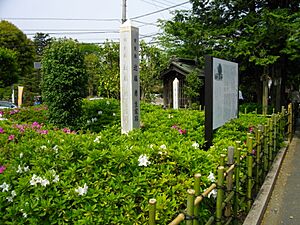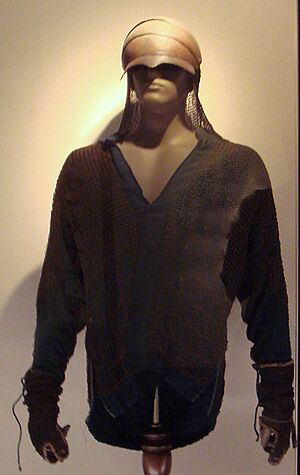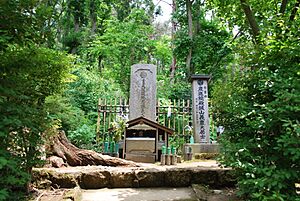Kondō Isami facts for kids
Quick facts for kids
Kondō Isami
|
|
|---|---|
|
近藤 勇
|
|
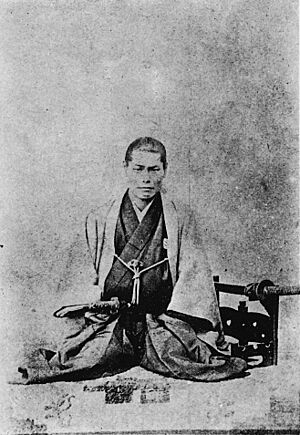
Kondō Isami (1834–1868)
|
|
| Shinsengumi Commander | |
| In office 1863–1868 |
|
| Preceded by | none (Briefly, office held jointly with Serizawa Kamo and Niimi Nishiki) |
| Personal details | |
| Born |
Miyagawa Katsugorō
November 9, 1834 Kamiishihara Village, Musashi Province, Japan |
| Died | May 17, 1868 (aged 33) Itabashi execution grounds, Itabashi, Edo, Japan |
| Spouse |
Matsui Tsune
(m. 1860–1868) |
| Domestic partners | Miyuki Oko |
| Relations | Kondō Shūsuke (adoptive father) Kondō Fude (adoptive mother) Kondō Hisatarō (grandson) |
| Children |
|
| Parents |
|
| Relatives | Miyagawa Rie (sister) Miyagawa Otogorō (brother) Miyagawa Sōbei (brother) Kondō Yūgorō (nephew) |
| Known for | Commander of Shinsengumi |
| Other names | Shimazaki Katsuta Shimazaki Isami Fujiwara no Yoshitake |
| Alias | Okubo Tsuyoshi Okubo Yamato |
| Military service | |
| Allegiance | Tokugawa bakufu |
| Branch/service | Rōshigumi (former) Mibu Rōshigumi (former) Shinsengumi |
| Years of service | 1863–1868 |
| Rank | Wakadoshiyori |
| Commands | Mibu Rōshigumi (former) Shinsengumi |
| Battles/wars | Ikedaya incident Kinmon incident Boshin War
|
Kondō Isami (近藤 勇, November 9, 1834 – May 17, 1868) was a famous Japanese swordsman and samurai who lived in the late Edo period. He was the fourth master of the Tennen Rishin-ryū sword fighting style. Kondō Isami is best known for leading the Shinsengumi, a special police force that protected the shōgun in Kyoto.
Contents
Early Life and Training
Kondō Isami was born Miyagawa Katsugorō on November 9, 1834. His family were farmers in Kami-Ishihara village, which is now part of Chōfu, Tokyo. This area was in Musashi Province, a region in Japan. He had two older brothers and an older sister.
When he was about 14 years old, in 1848, Katsugorō started training at the Shieikan. This was the main training hall, or dojo, for the Tennen Rishin-ryū sword fighting school.
Katsugorō loved to read, especially stories about brave warriors. He enjoyed tales like the Forty-seven rōnin, which is about samurai who sought revenge, and the Romance of the Three Kingdoms, a famous Chinese story about war and heroes.
His skills and knowledge caught the eye of Kondō Shūsuke, who was the third master of the Tennen Rishin-ryū school. In 1849, Shūsuke adopted Katsugorō. This meant Katsugorō became part of the Kondō family and took on a new name, Shimazaki Katsuta. Later, by 1858, he was known as Isami.
Kondō Isami was said to own a famous sword called "Kotetsu." This sword was believed to be made by a skilled swordsmith from the 1600s. However, some people think his sword might have been made by a different, equally famous swordmaker.
In 1860, Kondō married Matsui Tsune. Her father was an important official, which was a good connection for Kondō. On September 30, 1861, Isami officially became the fourth master of the Tennen Rishin-ryū school. He took the name Kondō Isami and became the head of the Shieikan dojo. The next year, his daughter, Kondō Tama, was born.
Before he became famous with the Shinsengumi, Kondō was considered for a teaching job at the Kōbusho. This was a special military training school set up by the Japanese government, called the Shogunate, to improve its military.
Joining the Shinsengumi
In 1863, the Tokugawa shogunate, which was the military government of Japan, created a large group of masterless samurai, called rōnin. Their job was to protect the shōgun, Tokugawa Iemochi, when he visited Kyoto. Kondō Isami joined this group, which was first known as the Rōshigumi. He joined with his close friend Hijikata Toshizō and other members from his dojo.
The Rōshigumi eventually broke up. But Kondō, Hijikata, and a few others stayed in Kyoto. They formed a new group called the Mibu Rōshigumi. This group worked as a police force in Kyoto, under the direct orders of the shogunate. They were supervised by Matsudaira Katamori, a powerful lord.
On August 18, 1863, their unit was given a new, famous name: the Shinsengumi. In July 1864, the Shinsengumi became very well known. They successfully stopped a group of anti-government samurai in an event called the Ikedaya Jiken, or Ikedaya Affair. This made the Shinsengumi famous for their policing work.
On July 10, 1867, Kondō and the other Shinsengumi members were given the rank of hatamoto. This was a high rank for samurai who directly served the shōgun.
Battles of the Boshin War
In January 1868, Kondō was wounded by a gunshot during the Battle of Toba–Fushimi. This was one of the first battles of the Boshin War, a civil war in Japan. After his injury, Kondō returned to Edo (modern-day Tokyo).
In Edo, he met with a military leader named Katsu Kaishū. Kondō was promoted to a high rank in the Tokugawa government, which was quickly losing power. Kondō then formed a new unit called the Kōyō Chinbutai, or "Pacification Corps." This unit was made up of the remaining Shinsengumi members. Kondō led them using a different name, Okubo Tsuyoshi.
On March 24, they left Edo to stop rebellions near Kōfu Castle. However, they soon heard that Imperial forces had already taken the castle. So, they settled in a town called Katsunuma.
On March 29, 1868, Kondō and his unit were attacked by Imperial forces at the Battle of Kōshū-Katsunuma. They fought bravely for about two hours but were eventually defeated. They managed to escape and went back to Edo.
Kondō later changed his alias again to Okubo Yamato.
Capture and Execution
On April 26, 1868, Kondō and his unit were caught by surprise by Imperial forces while training in Nagareyama. The Imperial forces suspected that "Okubo Yamato" was actually Kondō Isami. He was taken to Itabashi for questioning the next day.
His friend, Hijikata, tried to get a pardon for Kondō from Katsu Kaishū. A letter asking for Kondō's life to be spared arrived, but the request was denied.
Kondō was put on trial on April 30, 1868, and found guilty. As a result, Kondō Isami was executed at the Itabashi execution grounds on May 17, 1868. His nephew, Miyagawa Yūgorō, was among those who witnessed his execution.
Memorials and Graves
Kondō Isami has several memorial sites. One of the first was a grave built at Ten'nei-ji Temple in Aizu by Hijikata Toshizō. Hijikata was recovering from an injury nearby and personally oversaw the creation of this grave, where Kondō's hair was buried.
Another grave site is at Ryugenji Temple in Osawa, Mitaka, Tokyo. It is believed his body was brought here by his nephew and buried with his family.
A grave mound that is said to contain Kondō's head is located behind the Hozoji temple in Okazaki, Aichi Prefecture.
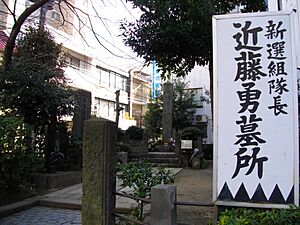
There is also a memorial known as the Grave of Shinsengumi in front of Itabashi Station. This memorial was built in 1875 by Nagakura Shinpachi, with help from other former Shinsengumi members. It honors both Kondō Isami and Hijikata Toshizō.
Kondō Isami's Legacy
In 1876, Kondō Isami's daughter, Kondō Tama, married his nephew, Miyagawa Yūgorō. Yūgorō then became the fifth master of the Tennen Rishin-ryū sword fighting school and took the name Kondō Yūgorō. He opened his own dojo, or training hall.
Tama and Yūgorō had one son named Kondō Hisatarō, born in 1883. Sadly, Kondō Tama died three years later.
In 1905, Kondō Hisatarō was killed while fighting in the Russo-Japanese War. He was only 22 years old. His death marked the end of Kondō Isami's direct family line.
Kondō Isami in Stories and Media
Kondō Isami is a very popular figure in Japanese stories and media. He often appears in TV shows, movies, books, anime, and manga.
- The NHK Taiga drama Shinsengumi! is a TV series that tells the story of Kondō's life.
- The character Kondō Isao from the anime Gintama is based on him.
- He also appears in the video game and anime series Hakuouki Shinsengumi Kitan.
- Kondō is a character in the manga series Kaze Hikaru and Peacemaker Kurogane.
- He is briefly mentioned in the anime Soar High! Isami, and the main character, Isami Hanaoka, is named after him.
- Kondō Isami also appears briefly in the anime Golden Kamuy.
- In the video game Ryu ga Gotoku Ishin! (and its remake Like a Dragon: Ishin!), he is a major character.
- He was portrayed by Takahiro Fujimoto in the 2021 movie Rurouni Kenshin: The Beginning.
- Kondō Isami is shown as a powerful warrior in Record of Ragnarok: Season 2, fighting gods for humanity's future.
- In the 2024 show With You I Bloom: The Shinsengumi Youth Chronicle, based on a 1963 manga, he was played by Akira Takano.
Links
- SHINSENGUMI 新選組 Shinsengumi Website
See also
 In Spanish: Kondō Isami para niños
In Spanish: Kondō Isami para niños


